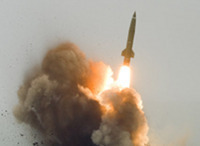Russia tests new missile with previously unachievable performance
Russia's "asymmetric response" to the US missile defense system, the test flight of which took place on Wednesday from Plesetsk spaceport, was an analogue of the sea-based intercontinental ballistic missile Bulava. Sources from the Russian rocket industry told the Kommesant newspaper that the two missiles were identical in their construction. They weigh nearly 36 tons, and are 12 meters in length. The two rockets also have the same amount of stages.

The new missile needs to be developed further. However, if all goes well, then Russia may have the new state-of-the-art strategic complex of highest, previously unachievable performance.
Colonel Vadim Koval, an official spokesman for Russia's Strategic Missile Forces, told reporters, without giving any details, that Russia conducted the first test flight of the prototype of the new ICBM. The launch was conducted from a mobile platform, the official said.
However, a source from the rocket industry told Interfax that it became the second launch for the missile. The first flight went unsuccessfully, although an official confirmation to that could not be found. Experts concluded that it goes about the little-known Avangard - a deeply modernized variant of the new Yars missile system.
Also read: Russia works on 100-ton monster ballistic missile
The new, yet still mysterious missile complex, can be a ground-based analogue of the Bulava system. The Moscow Institute of Thermal Technology started testing Bulava after a series of failed launches.
The performance of the missiles hold perfect prospects for the new weapons in the struggle with the US missile defense system, the elements of which are going to be deployed in Europe. NATO officials stated during the recent summit in Chicago (which Russia ignored) that the first stage of the European missile defense system was practically ready. It is worthy of note that in May, Nikolai Makarov, the chief of Russia's General Staff, announced a possibility of pre-emptive blow against European military objects in case of deployment of the European missile defense system.
Sources from the rocket industry of Russia said in connection with the above-mentioned launch that there was new fuel used for the new missile. The fuel reduces the time required for the work of the engines during the boost phase of the flight. This is the phase, when the missile is most vulnerable to air defense systems.
"As a result, the most complicated boost phase of the flight goes so quickly that the enemy does not have time to calculate its trajectory. The enemy will thus be unable to destroy it. In other words, we can say that our opportunities in overcoming missile defense will increase considerably," an official with the rocket industry told the Moskovsky Komsomolets newspaper.
Owing to the new fuel, the missile will be able to carry more warheads - up to ten. Nowadays, this can only be carried by super heavy (weighing more than 200 tons) silo-based liquid-fuel ICBMs RS-20 (SS-18). The missiles were developed in Ukraine. Russia still has them, but their resource is about to reach the limit after many prolongations.
The term - "asymmetric response" to the US missile defense system - was coined by Vladimir Putin during his second term as president in 2007. He referred to the lexicon of the Soviet times at an annual press conference and said that all responses to the deployment of the US missile defense system in Europe would be "asymmetrical, and yet highly effective."
Subscribe to Pravda.Ru Telegram channel, Facebook, RSS!


